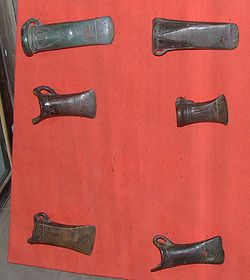
Celt (tool)
Encyclopedia


Archaeology
Archaeology, or archeology , is the study of human society, primarily through the recovery and analysis of the material culture and environmental data that they have left behind, which includes artifacts, architecture, biofacts and cultural landscapes...
term used to describe long thin prehistoric stone or bronze
Bronze
Bronze is a metal alloy consisting primarily of copper, usually with tin as the main additive. It is hard and brittle, and it was particularly significant in antiquity, so much so that the Bronze Age was named after the metal...
adze
Adze
An adze is a tool used for smoothing or carving rough-cut wood in hand woodworking. Generally, the user stands astride a board or log and swings the adze downwards towards his feet, chipping off pieces of wood, moving backwards as they go and leaving a relatively smooth surface behind...
s, other axe
Axe
The axe, or ax, is an implement that has been used for millennia to shape, split and cut wood; to harvest timber; as a weapon; and as a ceremonial or heraldic symbol...
-like tools, and hoe
Hoe (tool)
A hoe is an ancient and versatile agricultural tool used to move small amounts of soil. Common goals include weed control by agitating the surface of the soil around plants, piling soil around the base of plants , creating narrow furrows and shallow trenches for planting seeds and bulbs, to chop...
s.
Etymology
The term "celt" came about from what was very probably a copyist's error in many medieval manuscript copies of Job 19:24 in the Latin VulgateVulgate
The Vulgate is a late 4th-century Latin translation of the Bible. It was largely the work of St. Jerome, who was commissioned by Pope Damasus I in 382 to make a revision of the old Latin translations...
Bible, which became enshrined in the authoritative Sixto-Clementine
Sixto-Clementine Vulgate
Vulgata Sixto-Clementina, is the edition of Latin Vulgate from 1592, prepared by Pope Clement VIII. It was the second edition of the Vulgate authorised by this Pope, and it was used until the 20th century.- Clementine edition :...
printed edition of 1592; however the Codex Amiatinus
Codex Amiatinus
The Codex Amiatinus, designated by siglum A, is the earliest surviving manuscript of the nearly complete Bible in the Latin Vulgate version, and is considered to be the most accurate copy of St. Jerome's text. It is missing the Book of Baruch. It was produced in the Anglo-Saxon kingdom of...
, for example, does not contain the mistake. In the passage: Stylo ferreo, et plumbi lamina, vel certe sculpantur in silice (from Job
Book of Job
The Book of Job , commonly referred to simply as Job, is one of the books of the Hebrew Bible. It relates the story of Job, his trials at the hands of Satan, his discussions with friends on the origins and nature of his suffering, his challenge to God, and finally a response from God. The book is a...
19:24, "Let it indeed be carved with an iron pen on a plate of lead or in stone"), the certe ("indeed") was spelled as celte by mistake, which would have to be the ablative of a non-existent third declension noun celtes or celtis, the ablative case giving the sense "with/by a celt".
This is now considered to be the case by most scholars, although some are still prepared to consider the existence of a real Latin word. A 'Celt' was thus wrongly assumed to be a type of ancient chisel
Chisel
A chisel is a tool with a characteristically shaped cutting edge of blade on its end, for carving or cutting a hard material such as wood, stone, or metal. The handle and blade of some types of chisel are made of metal or wood with a sharp edge in it.In use, the chisel is forced into the material...
. Early eighteenth century antiquarian
Antiquarian
An antiquarian or antiquary is an aficionado or student of antiquities or things of the past. More specifically, the term is used for those who study history with particular attention to ancient objects of art or science, archaeological and historic sites, or historic archives and manuscripts...
s, such as Lorenz Beger, then adopted the word for the stone
Stone tool
A stone tool is, in the most general sense, any tool made either partially or entirely out of stone. Although stone tool-dependent societies and cultures still exist today, most stone tools are associated with prehistoric, particularly Stone Age cultures that have become extinct...
and bronze tools they were finding at prehistoric sites; the OED suggests that the imaginary etymological connection with the Celt
Celt
The Celts were a diverse group of tribal societies in Iron Age and Roman-era Europe who spoke Celtic languages.The earliest archaeological culture commonly accepted as Celtic, or rather Proto-Celtic, was the central European Hallstatt culture , named for the rich grave finds in Hallstatt, Austria....
s may have assisted its passage into common use.
There are other possibly related words found in late Medieval Europe, all possibly descended from the Vulgate text, which was taken to be genuine Latin. There are two Rhineland charters in Latin, which use such phrases as celtes seu fracmina lapidum to describe chips of stone to be used for making a road. There may also have been a rare Welsh word cellt, meaning "flint stone" or "[nut]shell", but the OED calls it "obscure".

